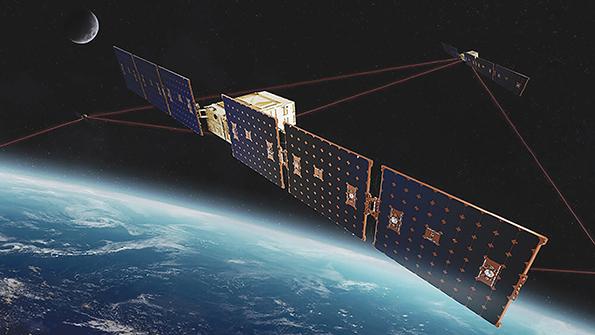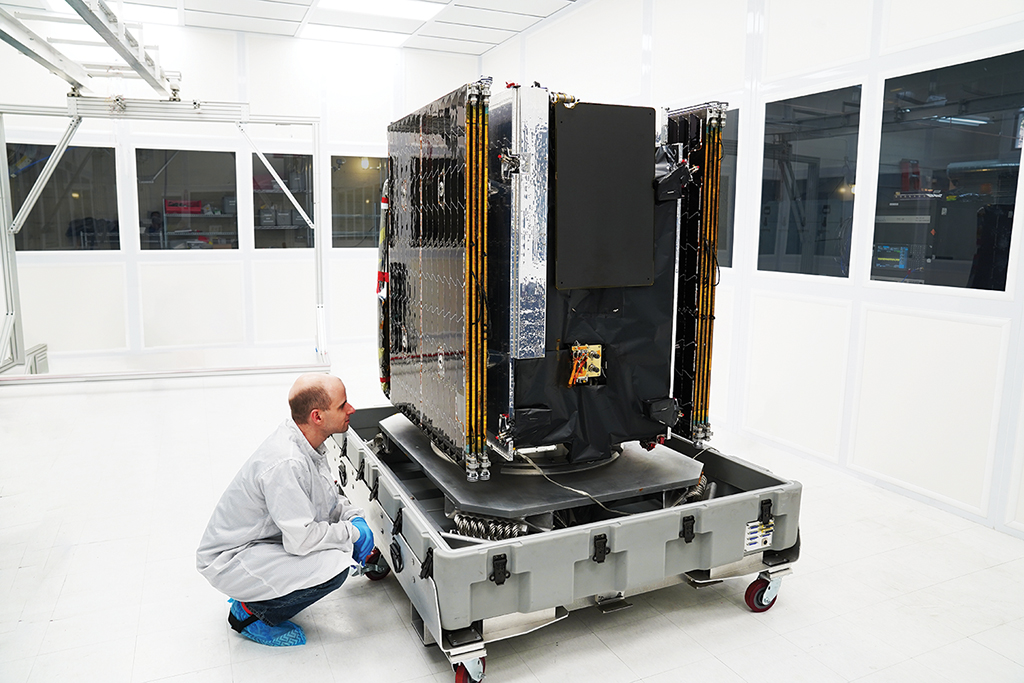Big Military Sats Look For A Place Amid The Smallsat Trend

Terran Orbital’s bus for the SDA’s Tranche 0 Transport Layer is many times smaller than a conventional communications satellite.
"Big, fat, juicy targets,” an “old approach” and “fragile, undefendable”—these are some of the ways Pentagon leaders have described large, conventional satellites in recent years. As China and Russia field anti-satellite weapons, including missiles and jammers, the U.S. Defense Department worries that its most capable—and expensive—satellites are vulnerable to being easily knocked out in a war.
Instead, Washington is enamored with small, relatively cheap and distributed satellites, such as SpaceX’s Starlink, a constellation of laser-linked communications satellites operating in low Earth orbit that have been vital to orchestrating Ukraine’s defense against the Russian invasion. The U.S. Space Force plans to launch hundreds of small satellites to field a variety of roles previously only handled by its biggest spacecraft.
- Large spacecraft will probably play a role for a while longer
- The Pentagon is likely to maintain hybrid architectures of small, medium and large satellites
Yet prime defense contractors say: Do not write the death certificate for large satellites. Companies such as Boeing, Northrop Grumman, Airbus and Lockheed Martin—historically the manufacturers of large military satellites—say the type is likely to endure for a while longer, albeit not in the dominant role it once played.
As more countries set up new space service branches, they are looking for their own satellites. And that may sometimes mean large, conventional, geostationary communications satellites—spacecraft that, while expensive to build and painful to lose in battle, individually can provide a higher data rate capacity.
Large satellites also are likely to find a role within hybrid constellations—interconnected communications satellites in low, medium and geostationary orbit, manufacturers say.
What is more, it has been nearly 5.5 years since U.S. Air Force Gen. John Hyten, then-head of Strategic Command, dismissed conventional satellites as “big, fat, juicy targets.” In 2017, he remarked: “We are going to go down a different path. And we have to go down that path quickly.” But the Pentagon is still buying large satellites.
“These exact type of spacecraft continue to get ordered,” says Chris Quilty, founder and partner at research firm Quilty Analytics. “We find the pace of movement away from large satellites to be surprisingly slow.”
Since Hyten’s comments, the Defense Department has ordered billions of dollars’ worth of large satellites for missions including missile warning and communications, he notes.
“If anything, it appears that the Space Force wants to procure Hyten’s nightmare satellites concurrent with smaller, disaggregated systems like the Space Development Agency’s [(SDA)] Proliferated Warfighter Space Architecture [(PWSA)] constellation,” Quilty says.
The PWSA is an in-development constellation of hundreds of small satellites consisting of seven different “layers”—types of satellites performing tasks such as communications, missile warning, missile tracking, Earth observation and navigation. The satellites are planned to be placed in low Earth orbit—a region that, because it is closer to the planet’s surface, costs less to reach, makes it easier to observe targets and lessens the time—latency—it takes to send and receive transmissions from the surface.
The SDA plans to launch its first batch of the small satellites, Tranche 0, before the end of March from Vandenberg Space Force Base in California. The launch aboard a SpaceX rocket is set to include Tracking Layer or Transport Layer satellites—or possibly both—although the manifest has yet to be finalized.
Tracking Layer satellites are designed to spot and track hypersonic and ballistic missile launches. Transport Layer spacecraft are communications satellites designed to connect to other platforms in the PWSA using a mesh network of laser communications systems. The Tranche 0 satellites are to be a minimal viable product intended to demonstrate the functionality of the larger constellation.
Satellites in the PWSA constellation are significantly smaller than conventional spacecraft operated by the Space Force. For instance, Terran Orbital’s Tranche 0 Transport Layer satellite bus, 10 of which were built for prime contractor Lockheed Martin, is based on the company’s Zuma, a platform with a launch mass no more than 882 lb. Boeing’s Wideband Global Satcom 10+ (WGS), a geostationary communications satellite built for the Space Force, has a reported launch mass of 13,200 lb.
The Defense Department sees a variety of advantages in buying smaller satellites. For one, distributing communications, missile tracking, navigation or reconnaissance capabilities across multiple spacecraft makes individual satellites “attritable”—cheap enough to be lost in combat and then replaced, without breaking the budget or hurting the overall capabilities of the constellation.
“One of the tenets of competitive endurance is that we have to deny first-mover advantage, and I think the best way to do that is through resiliency,” Gen. Chance Saltzman, chief of space operations for the Space Force, said at the Air and Space Forces Association Warfare Symposium in March. “If you can, make it a targeting problem for your adversary: ‘Well, how many satellites do I have to shoot down to have a mission effect?’”
If the answer is just one satellite—especially an expensive spacecraft that takes years to build—then an adversary might be tempted to make a surprise attack.
“If that answer is 350 [satellites], now this creates a much more resilient architecture [and] a much bigger problem for an adversary to attack,” Saltzman said.

Smaller satellites also are better equipped for journeys deeper into space, Johnathon Caldwell, vice president and general manager of military space at Lockheed Martin, said in March at the Satellite 2023 show. “It’s not just about [geostationary orbit] anymore. We are also moving into cislunar [space],” he said. “The cislunar orbit is not an orbit for large-class vehicles.”
Using smaller satellites, which often have life spans of about five years and need to be replaced frequently, can allow an operator to incorporate the latest technology.
“To gain speed, we need to shorten development cycles by building smaller satellites, acquiring ground and software-intensive systems in smaller chunks that can be delivered faster, using existing technology designs to minimize nonrecurring engineering, taking advantage of commercial systems and capabilities and, most importantly, delivering programs on-cost and on-schedule,” Frank Calvelli, assistant secretary of the Air Force for space acquisitions and integration, said in January at the Space Acquisition Forum.
The Space Force aims to use not just smaller satellites, but also existing technologies, including commercial technologies, to minimize nonrecurring engineering. It also wants to use fixed-price contracts of no more than 2-3 years in duration from start to launch, Calvelli said.
“Those of us who have been in the business a long time know you just can’t build big fast,” Calvelli says. “Even with minimal nonrecurring engineering or minimal design changes, big satellites take time. They require a big bus, structures, big tanks, big payloads and big components.”
The SDA plans to use small-satellite buses from manufacturers that also have pioneered using diminutive spacecraft for commercial low-Earth-orbit communications and Earth-observation applications. To obtain a piece of this new way of doing business, prime manufacturers have partnered and subcontracted with small-satellite companies.
Going small while using standardized buses and components offers advantages to satellite manufacturers, too.
“The profit is better in this market than it is for big satellites because it’s not a one-of-a-kind satellite. It’s not a big thing that is extremely risky,” Jean-Marc Nasr, president of Airbus Defense and Space SAS, said at the Satellite 2023 show.
In July, Northrop Grumman contracted Airbus to provide 42 satellites—based on its modular, 200-kg (440-lb.) commercial satellite called Arrow—for the SDA’s Tranche 1 Transport Layer. The Arrow is derived from a satellite bus made for OneWeb, a commercial operator of low-Earth-orbit communications satellites.
Still, Airbus, which manufacturers big geostationary communications satellites such as the Syracuse IV for the French Armed Forces, does not see the large-satellite category going away completely.
“I still see the demand for the military [communications] satellites for [geostationary orbit],” Nasr said, noting the high data throughput and cybersecurity hardening requested by military customers. “I don’t see this as possible for small satellites in [geostationary orbit].”
Lockheed Martin says new orders from other countries including Australia, Canada and the UK as well as Nordic and Eastern European nations that have seen the importance of space capabilities in the Russia-Ukraine war could make up for slackening demand for large satellites from the Defense Department.
“Countries that had traditionally gone through the U.S. to acquire a [Foreign Military Sales] solution or to buy time on a U.S. system are now very determined to buy their own systems,” Caldwell said. “They will come up with their own requirements. They’ll ask for systems designed for them.”
Those countries have yet to decide whether to use a large satellite in geostationary orbit or a proliferated constellation in low Earth orbit—or perhaps some combination, he said. Caldwell mentioned the Australian Defense Force’s Joint Project 9102 communications satellite program and the UK Defense Ministry’s Skynet Enduring Capability communications satellite program as two competitions on which Lockheed Martin is focused.
Even in geostationary orbit, however, typically an area dominated by large, conventional satellites, upstart small-satellite manufacturers are elbowing in. In February, Astranis, a San Francisco-based developer of a small geostationary communications satellite dubbed MicroGEO, won a $4.5 million contract to show that its software-defined radio payload can transmit the U.S. Defense Department’s Protected Tactical Waveform.
SWISSto12, a Lausanne, Switzerland-based specialist in 3D printing of radio frequency cavity-based components, antennas and antenna arrays, also has expressed interest in building small geostationary satellites for the U.S. military. The company initially plans to use its radio frequency technology to develop a small geostationary Earth-orbit communications satellite called the HummingSat for telecommunications company Intelsat. That commercial satellite is scheduled to launch in 2025.
Geostationary orbit still offers advantages for military applications, says Emile de Rijk, SWISSto12 founder and CEO. “It is very hard to put a satellite into [geostationary orbit] because it’s very far. But it means it’s also very hard to go damage someone else’s satellite in [geostationary orbit] because it’s very far,” he says. “If someone were to try something like that, you could see it coming days ahead of time, so you have time to react.”
An operator could use multiple small geostationary satellites to cover a region of the Earth, breaking up the risk and cost of that type of coverage that otherwise would all fall on a single large, expensive spacecraft, he adds.
However, switching to new satellites, especially in new orbits, comes with technical and logistical challenges, Quilty says. U.S. military users already have terminals to connect to the WGS and Advanced Extremely High-Frequency geostationary communications satellites, he points out.
“The Space Development Agency has admitted it is behind in the acquisition of user terminals for its PWSA constellation, which will almost certainly require electronically steered antennas like those offered by Starlink and [Amazon’s] Kuiper,” Quilty says. “This portends difficulty in shifting warfighters from WGS to PWSA.”
Many prime contractors envision legacy large satellite systems operating alongside smaller upstarts for years, perhaps even integrating as part of a multiple-orbit constellation.
“Big sats, small sats, medium sats, I think there’s going to be a role for all kinds of satellites,” says Michelle Parker, vice president of Boeing Space Mission Systems. “It’s not about an either-or.”
Integrating large satellites such as the WGS into Space Force constellations of smaller satellites via laser communications systems, “those are things that are being looked at,” she adds. “In order to have the best operational, most resilient system, you’ll start to see those links.”
Much of the Space Force’s decision-making likely will depend ultimately on the success of the SDA’s PWSA constellation, Quilty says. “Mimicking the ‘go fast and break things’ philosophy of SpaceX, the SDA’s spiral development approach has achieved impressive success in its goal to deliver new tranches of satellites every two years,” he says. “If the SDA’s approach proves successful, it could force other procurement agencies to adjust their approach.”






